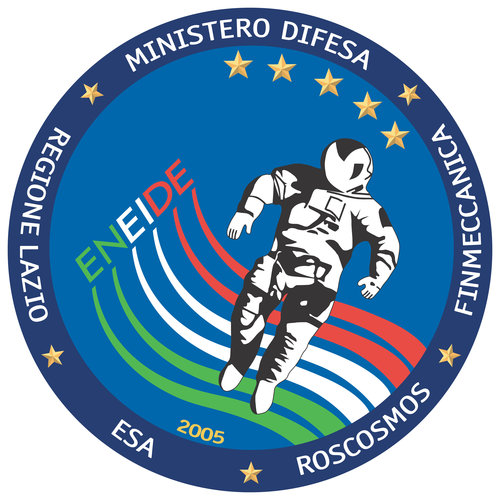Roberto Vittori
Born on 15 October 1964 in Viterbo, Italy, Roberto Vittori is married to the former Valeria Nardi of Citta’ di Castello, Italy; they have three children. Roberto enjoys soccer, running, swimming and reading.
Education
- Roberto graduated from the Italian Air Force Academy in 1989 with a degree in Aeronautical Science
- Completed basic training with the US Air Force at Reese Air Force Base in Texas, US, in 1990
- Graduated from the US Navy Test Pilot School in 1995
- Completed the Italian Air Force’s Accident Prevention course (Guidonia AFB, Italy) and Accident Investigation course (Kirtland AFB, New Mexico, US) between 1996 and 1997
- Graduated from the NATO Defense College Senior Course 108 in 2006
- Completed a master’s degree in physics in December 2007
Special honours
- Academic award at the Undergraduate Pilot Training, Reese Air Force Base, Texas, US
- Honour student at the Test Pilot School, Patuxent River, Maryland, US
- Honour student at the US Flight Safety School, Kirtland Air Force Base, New Mexico, US
- Italian Air Force Long Service Medal (1997)
- Gold Medal to the Aeronautical Value awarded by the President of the Italian Republic (2002)
- Special recognition as ‘Commendatore della Repubblica’ awarded by the President of the Italian Republic (2005).
Experience
Following graduation from pilot training in 1990, Roberto Vittori flew Tornado GR1 aircraft with the 155th Squadron, 50th Wing, Piacenza, Italy from 1991 to 1994. During that time, he qualified for day and night air-to-air refuelling as well as a formation leader.
In 1995, he completed the US Navy Test Pilot School training. He then served at the Italian Test Centre as project pilot for the development of the new European aircraft, the EuroFighter EF2000, until 1998. From 1996 to 1998, he was the national representative in the Beyond Visual Range Air-to-Air Missile research and development programme.
In 1997, he attended the US Air Force Flight Safety School. From 1997 to 1998, Roberto was wing Flight Safety Officer at the Italian Test Centre. He was also a teacher of aerodynamics for the Italian Air Force’s Accident Investigation Course.
Roberto Vittori is a colonel in the Italian Air Force. He has logged nearly 2000 hours in over 40 different aircraft, including F-104, Tornado GR1, F-18, AMX, M-2000, G-222 and P-180.
In July 1998, he was selected as an astronaut by Italy’s ASI space agency in cooperation with ESA and, one month later, he joined ESA’s Astronaut Corps, based at the European Astronaut Centre in Cologne, Germany.
In August 1998, Roberto was relocated to NASA’s Johnson Space Center in Houston, USA, and entered the 1998 Astronaut class for assignments on the Space Shuttle and International Space Station. Roberto completed his Mission Specialist training and performed technical duties in the Space Shuttle Operations Systems Branch, Robotics, Future Vehicle and International Space Station Branch.
In August 2001, he took up training as flight engineer at the Gagarin Cosmonaut Training Centre in Star City, Russia, in preparation for his first spaceflight.
In August 2002, Roberto returned to Johnson Space Center, where he supported the New Generation Space Vehicles Branch.
After Space Shuttle Columbia was lost, Roberto served in the Tiger Teams accident investigation.
In October 2004, Roberto took up training again at Star City for his second mission to the International Space Station.
Between February 2006 and August 2008, he was detached to the Italian Air Force under an agreement with ESA. During the detachment he served on the Board of ASI’s Technical Scientific Committee.
Spaceflight experience
From 25 April to 5 May 2002, Roberto participated in a taxi-flight to the International Space Station, under an agreement between Roscosmos, ASI and ESA. This mission served to deliver a new Soyuz spacecraft and emergency escape vessel to the Station.
His second mission to the International Space Station, the Italian Eneide mission took place 15–25 April 2005. As Soyuz flight engineer on launch and return, Roberto had an active role in piloting and docking the spacecraft. On the International Space Station, he Roberto performed an intensive programme of experiments.
Roberto’s third mission, on Shuttle STS-134, was an assembly mission to the International Space Station from 16 May to 1 June 2011. His DAMA mission was provided by ASI in agreement with NASA. The Shuttle delivered the Express Logistics Carrier, but the main task was to install the AMS-02 cosmic-ray detector to examine dark matter and the origin of the Universe. Roberto grappled the six-tonne AMS-02 with the Space Shuttle’s robotic arm and moved it to the Station for installation. This was the final flight of Space Shuttle Endeavour.















 Germany
Germany
 Austria
Austria
 Belgium
Belgium
 Denmark
Denmark
 Spain
Spain
 Estonia
Estonia
 Finland
Finland
 France
France
 Greece
Greece
 Hungary
Hungary
 Ireland
Ireland
 Italy
Italy
 Luxembourg
Luxembourg
 Norway
Norway
 The Netherlands
The Netherlands
 Poland
Poland
 Portugal
Portugal
 Czechia
Czechia
 Romania
Romania
 United Kingdom
United Kingdom
 Slovenia
Slovenia
 Sweden
Sweden
 Switzerland
Switzerland

































